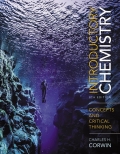
(a)
Interpretation:
The element out of
Concept introduction:
The periodic table represents elements in order according to their increasing
(b)
Interpretation:
The element out of
Concept introduction:
The periodic table represents elements in order according to their increasing atomic numbers. In the modern periodic table, the horizontal rows are known as periods, and the vertical columns are known as groups. The energy required to remove an electron from an ion or isolated atom is known as its ionization energy.
(c)
Interpretation:
The element out of
Concept introduction:
The periodic table represents elements in order according to their increasing atomic numbers. In the modern periodic table, the horizontal rows are known as periods, and the vertical columns are known as groups. The energy required to remove an electron from an ion or isolated atom is known as its ionization energy.
(d)
Interpretation:
The element out of
Concept introduction:
The periodic table represents elements in order according to their increasing atomic numbers. In the modern periodic table, the horizontal rows are known as periods, and the vertical columns are known as groups. The energy required to remove an electron from an ion or isolated atom is known as its ionization energy.
Want to see the full answer?
Check out a sample textbook solution
Chapter 5 Solutions
EBK INTRODUCTORY CHEMISTRY
- Refer to the periodic table and predict the number of valence electrons for an atom of each of the following representative elements: (a) Na (b) Al (c) S (d) Xearrow_forwardWhich of the following elements is expected to have the highest SECOND IONIZATION ENERGY: (A) Be (B) Ca (C) Mg (D) Naarrow_forwardAmong the elements B, Al, C and Si(a) Which has the highest first ionization enthalpy?(b) Which has the largest atomic radius?arrow_forward
- Arrange in order of increasing nonmetallic character. (a) the Period 3 elements Cl, Si, and Na (b) the Group 7A elements I, Br, and Farrow_forwardIn general terms, how does each of the following atomic properties influence the metallic character of the main-group elements in a period?(a) Ionization energy(b) Atomic radius(c) Number of outer electrons(d) Effective nuclear chargearrow_forwardAn element reacts with oxygen to give a compound with a high melting point. This compound is also soluble in water. The element is likely to be(a) Calcium(b) Carbon(c) Silicon(d) Ironarrow_forward
- (a) List four physical characteristics of a solid metal. (b) List two chemical characteristics of a metallic element.arrow_forwardGiven the following elements: Si, Sr, Cu, Ti, S (a) which of those elements would have the larget atomic radius? (b) which of those elements would have the highest ionization energy? (c) which of those elements would have the lowest electronegativity?arrow_forwardArrange in order of increasing nonmetallic character. (a) the period 4 elements Ga, Ge, Ti (b) the Group 5A elements P, Bi, and Narrow_forward
- According to general trends in the periodic table, predict which element in each of the following pairs has the larger atomic radius. (a) Rb or Sr (b) As or Se (c) Pb or Bi (d) I or Xearrow_forwardState weather each of the following properties of the representative elements generally increases or decreases. (A) from left to right across a period. (B) from top to bottom within a group: metallic character, atomic size, ionization energy, acidity of oxides.arrow_forward56. Refer to the periodic table and write the predicted electron configuration for each of the following elements. (a) B (c) Na (e) Ge (b) Ti (d) O (f) Ba (h) Kr (g) Pdarrow_forward
 ChemistryChemistryISBN:9781305957404Author:Steven S. Zumdahl, Susan A. Zumdahl, Donald J. DeCostePublisher:Cengage Learning
ChemistryChemistryISBN:9781305957404Author:Steven S. Zumdahl, Susan A. Zumdahl, Donald J. DeCostePublisher:Cengage Learning ChemistryChemistryISBN:9781259911156Author:Raymond Chang Dr., Jason Overby ProfessorPublisher:McGraw-Hill Education
ChemistryChemistryISBN:9781259911156Author:Raymond Chang Dr., Jason Overby ProfessorPublisher:McGraw-Hill Education Principles of Instrumental AnalysisChemistryISBN:9781305577213Author:Douglas A. Skoog, F. James Holler, Stanley R. CrouchPublisher:Cengage Learning
Principles of Instrumental AnalysisChemistryISBN:9781305577213Author:Douglas A. Skoog, F. James Holler, Stanley R. CrouchPublisher:Cengage Learning Organic ChemistryChemistryISBN:9780078021558Author:Janice Gorzynski Smith Dr.Publisher:McGraw-Hill Education
Organic ChemistryChemistryISBN:9780078021558Author:Janice Gorzynski Smith Dr.Publisher:McGraw-Hill Education Chemistry: Principles and ReactionsChemistryISBN:9781305079373Author:William L. Masterton, Cecile N. HurleyPublisher:Cengage Learning
Chemistry: Principles and ReactionsChemistryISBN:9781305079373Author:William L. Masterton, Cecile N. HurleyPublisher:Cengage Learning Elementary Principles of Chemical Processes, Bind...ChemistryISBN:9781118431221Author:Richard M. Felder, Ronald W. Rousseau, Lisa G. BullardPublisher:WILEY
Elementary Principles of Chemical Processes, Bind...ChemistryISBN:9781118431221Author:Richard M. Felder, Ronald W. Rousseau, Lisa G. BullardPublisher:WILEY





